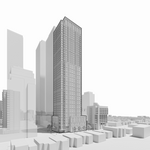M II A II R II K
Senior Member
Surely the Halton museum would take at least one of them.
Someone maybe able to create the software on a smartphone to run them, but it's the interface and the devices they connect to that is the problem. Would you be able to use the storage devices of the 1980's to interface with? Would you want to?I think preserving a car or two for a static display would be great considering these trains aren't just a piece of Toronto's history but also the provinces since it was the provinces UTDC that designed the trains and a lot of the tech surrounding them. They are a piece from a bygone era when the Province was more actively involved in the development of new technologies. They can be used as a set piece for the history of Ontario's involvement with the development of Mag-Lev technology, to the unbuilt GO ALRT project, the the development of one of the first successful Light-Metro systems.

Surely the Halton museum would take at least one of them.
In terms of the mandate for what a museum or preservation society is supposed to be, that would come under the heading of 'travesty'.At one time, Halton County did equip a Gloucester subway car with a trolley pole for operation, but it later ended up (wisely) in static display.
In terms of the mandate for what a museum or preservation society is supposed to be, that would come under the heading of 'travesty'.
At one time, Halton County did equip a Gloucester subway car with a trolley pole for operation, but it later ended up (wisely) in static display.
I definitely see a car sent to HCRY for static display – it won’t need much work to do so, apart from regauging the trucks. The trouble with HCRY is that there are many little projects going on all at once, along with the necessary maintenance of its plant and collection. If only they could focus on one or two restorations at a time, they’d get a lot more done.
In big picture terms, my view is that while a static unit at HCRY would be kinda nice, it might actually be better suited to the Toronto Railway Museum (maybe genuinely send one car to each, splitting a married pair). A unit to Science Center would also make a lot of sense to me, and fit really well with both their mandate and the technology development angle of it (honestly, I'd love to see them get the actual protype cars from Kingston); this is a bit of a nonstarter if they actually move to Ontario Place of course...The overriding imperative for any museum or preservation society is, Know the limits of your capabilities and only conserve what you can repurpose and maintain on a sustainable basis.
Museums are not junkyards, and nothing harms preservation more than acquiring more than the museum can maintain and having most of it sit in the weeds rusting away. Sadly sometimes museums dilute their own collection by allowing individuals to take on projects on their own initiative that they are unable to finish on their own, despite the museum's destiny depending on other projects that the individual isn't as keen on. Sometimes museums need to tell their volunteers, look - our priority is x and that's all we will allow you to work on right now, even if you have a lifelong passion for y. And sometimes museums need to refuse new artifacts - or cull their collection strategically.
Fitting a trolley pole to a G-car and running it as such is a historical aberration - and it's just plain impractical, especially given the incompatibility with the track and the rider amenities at HCRY.
I will be happy if HCRY (or any other museum) decides that a piece of SRT rolling stock fits within their mandate, and makes a strategic decision to add that exhibit to their program. But I would be disappointed if they don't properly work that into their strategic plan so that the conservation - be it static or otherwise - is sustained.
I don't think that my future grandchildren will be deprived if they never ride a SRT railcar in a museum. It would be something meaningful to interpret as part of our civic history - but rusting in the weeds isn't doing that..
- Paul
In big picture terms, my view is that while a static unit at HCRY would be kinda nice, it might actually be better suited to the Toronto Railway Museum (maybe genuinely send one car to each, splitting a married pair).
What is the grade at Kennedy station? It doesn't appear to be steeper than the Bathurst St hill north of Davenport, which streetcars handle fine.
What about getting the same cars but without the reaction rail? Similar to what they use on the YUS line now? Did BBD or now Alstom have that as an option? That reaction rail from my understanding means, your stuck with that one supplier and can't explore other options to get a better competitive deal.
We probably are, there's definitely a way to mitigate it. But it definitely adds to the cost of upgrading the vehicles on the SRT, and as said above Transit City was just around the corner at the time.I thought we were discussing the "millions" in extra costs for using the shorter Mark I vehicle length, rather than the length that's now being used in the Mark II to Mark V vehicles. I think $170 million was a given.
Yes ... but I don't think there was ever any further design to mitigate this. For example, would heating the reaction rail solve this? Or switching to overhead catenary (which would be a challenge in the tunnel).
Either way, I think we are getting into faeries on pinhead territory.
It's a special challenge for museums/societys that deal in 'big things'; railway equipment, aircraft, etc. Facilities that enable inside storage and display are beyond the financial ability of most. In 'normal' museums, it's not unusual for only a portion of its holdings to be on public display. The rest is held for historical preservation, research, restoration, etc.The overriding imperative for any museum or preservation society is, Know the limits of your capabilities and only conserve what you can repurpose and maintain on a sustainable basis.
Museums are not junkyards, and nothing harms preservation more than acquiring more than the museum can maintain and having most of it sit in the weeds rusting away. Sadly sometimes museums dilute their own collection by allowing individuals to take on projects on their own initiative that they are unable to finish on their own, despite the museum's destiny depending on other projects that the individual isn't as keen on. Sometimes museums need to tell their volunteers, look - our priority is x and that's all we will allow you to work on right now, even if you have a lifelong passion for y. And sometimes museums need to refuse new artifacts - or cull their collection strategically.
Fitting a trolley pole to a G-car and running it as such is a historical aberration - and it's just plain impractical, especially given the incompatibility with the track and the rider amenities at HCRY.
I will be happy if HCRY (or any other museum) decides that a piece of SRT rolling stock fits within their mandate, and makes a strategic decision to add that exhibit to their program. But I would be disappointed if they don't properly work that into their strategic plan so that the conservation - be it static or otherwise - is sustained.
I don't think that my future grandchildren will be deprived if they never ride a SRT railcar in a museum. It would be something meaningful to interpret as part of our civic history - but rusting in the weeds isn't doing that..
- Paul

I favour this approach above all. It's local to the original line's stomping grounds, it's accessible, and conveniently located. I fear greatly however that no one who can influence policy will think this a good idea and the entire system will be wiped from our collective minds and memories.I am thinking of preserving one of the old stations (say STC) and putting one of the trainsets in it. You can seal the existing structure for weather protection.
AoD




